The Bell Inn dominated the crossroads at the centre of Upminster for around 200 years until its demolition in the summer of 1963, to be replaced by a featureless parade of shops with an ugly car park above. These days it may well have been saved and given an imaginative renovation that breathed new life into the premises but in the early 1960s the conservation movement had not taken hold and we can only look back with nostalgia at what might have been.
The Bell Inn was one of the grand buildings of Upminster erected by Sir James Esdaile. According to Wilson’s 1856 History the original inn building “stood back from the road, on the site which the granary now occupies”. But 25 years later in his 1881 History and in other later notes Wilson stated that the premises “stood some 40 yards S.E. of the present house”, in what must now be part of the grounds of Upminster Infant & Junior School. Wilson also said that his father Thomas (b.1790) told him that the inn’s brickwork was carried out by Charles Cove, master bricklayer of Hornchurch (1737-1820), with whom was acquainted. Wilson’s father was also cited as the source of the earlier inn’s location and dating of the new Bell as being built in 1765 (ERO T/P 67/6 – no. 3330).
However, a plan attached to a deed at the Essex Record Office (ERO D/DU 18/23) dated 23rd May 1760 appears to show the building in its recognised location, rather than that suggested by Wilson. The Story of Upminster also suggests that Esdaile enclosed the village green in order to build his new hostelry but this deed shows that far from unilaterally enclosing the manorial waste and village green, James Esdaile only enclosed waste with the agreement of the Lord of the Manor of Gaynes and paying compensation by following the proper legal processes.
The Bell formed part of the New Place Estate which James Esdaile inherited through his second wife, Mary Mayor, on the death in July 1757 of her aunt Sarah Mayor, as New Place was the principal part of Mary’s dowry. New Place deeds from the early 18th century consistently describe the premises as “The Blew Bell” – a term that does not seem to have appeared in print before. At some stage, possibly after its rebuilding, it just became “The Bell”. According to Wilson, to the south of the Bell there was a horse pond, shown on the 1842 Tithe Map as being close to the boundary with High House. It was filled in about 1850 and became the Bell’s garden.

1897 25″ Ordnance Survey map 2nd edition
The earliest known landlord has been named as Elizabeth Saward in 1632 and Stephen Lowden was in charge five years later. In 1722 the Bell was said to have been formerly in the tenure of Whyte, late of John King, deceased and in that year of William Keggal.
Wilson states (ERO: T/P 67/6) that “George Burling the elder lived as landlord in both the old and present house” but as George Burling died in May 1757 this seem extremely unlikely as James Esdaile did not own the property until three months later. It’s likely that Burling’s widow Mary took over as landlady, until her 1760 marriage to Isaac Bone, carpenter who then became the licensee until William Thompson took over in the spring of 1768. The evidence of the Upminster rate books is inconclusive about when the Bell may have been rebuilt. When William Thompson took over in 1768 the quarterly poor rates were 7s 6d but these increased to 10s by June 1768. However, the rates had increased from 5s to 7s 6d after Isaac Bone took over in the spring of 1760.
From 1769 onwards there is a continuous record of successive landlords, starting with William Thompson from 1769 to 1773, followed by his widow Jane until 1778. Interestingly Thompson described himself in his will in 1774 as formerly a sailmaker of St George in the East, but now an “Innholder”. Andrew Hay succeeded Jane Thompson and after he died in August 1783, his widow Ann continued in charge until her wedding in April 1784 to George Burling the younger, who had been born at the Bell over 30 years earlier. This George Burling was the publican from 1784 to 1793, before William Gann was landlord for five years from 1794 until his death aged 58 in October 1799. Joseph Lee, the landlord for almost the next 25 years until 1823, on his retirement built Oak Lodge in St Mary’s Lane. He was followed by James Purkis (d. 1831), Thomas Clarke (until 1843) and John Braley Seabrook, until 1856.
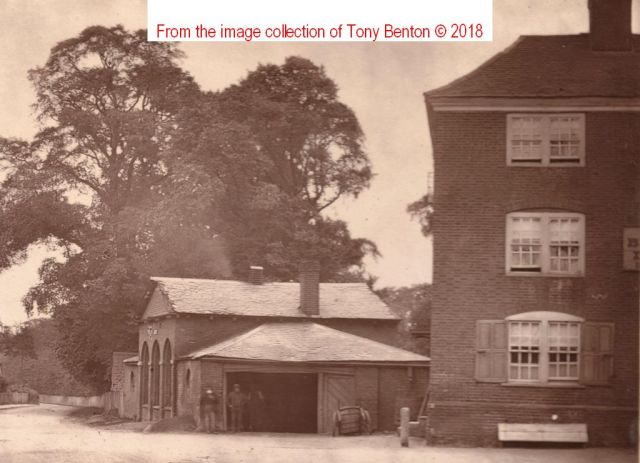
- The earliest photo of the Bell and Eldred’s smithy c. 1880
Henry Day and his wife Priscilla came to Upminster as the new publicans of the Bell on 1 December 1856, the year following their marriage. Harry Day had tried his luck in Australia as a young man taking an assisted passage in 1842, and it’s said that while he was there he tried his hand at gold prospecting and also worked as plumber. However, Day had returned to Britain before 1851 and resumed work with his father’s painting business in Pewsey, Wiltshire. Taking on the running of the Bell in 1856 seems quite a career change, but he was no doubt supported by his wife Priscilla’s earlier experience as a barmaid in Hampshire!
The Days were to stay at the Bell almost 50 years, raising six daughters. As it’s often reported the 1881 census enumerator Stephen Martin inappropriately noted that the five daughters then at home were “pretty girls”. Harry Day was an invalid for the last few years before his death in 1885, and Priscilla carried on the business for 20 years, retiring in March 1905 to live at Locksley Villa opposite, dying there two years later.
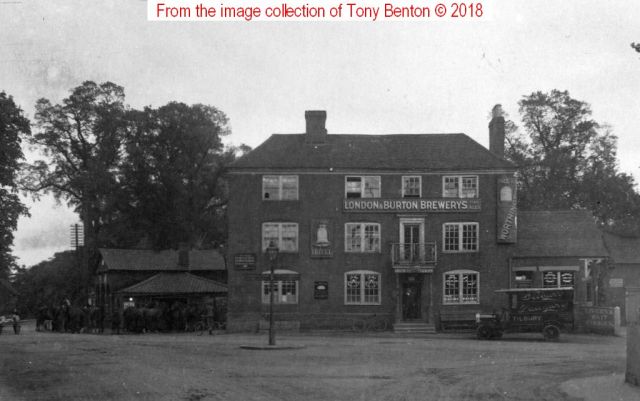
Bell Inn & a well attended smithy c.1908. Albany Laundry, Tlibury van on the right.
The Bell continued in the Esdaile family ownership until it was sold privately in August 1886 for £3,200 to Frederick Seabrook of the Earl of Essex, Manor Park. He was the second son of John Braley Seabrook, a former landlord at the Bell from 1843 to 1856, but in December 1889 the business was sold by auction and acquired by the London & Burton Brewery Company.
In 1911 the Bell was described as being in poor repair which is probably why two years later the owners carried out a major refurbishment, which included redesigning the ground floor windows and installing a remodelled entrance and porch, after the planned changes were initially met with local resistance. Henry Turnell took over the licence in 1912 after having been a grocer in Prittlewell and licensee of the Whitmore Arms, Orsett.
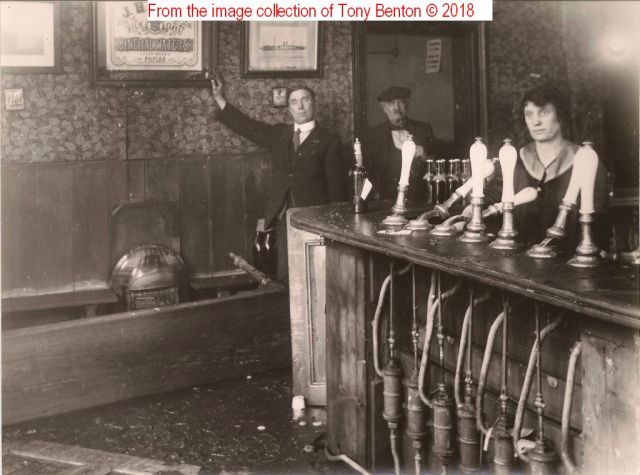
An early photo of the interior of the Bell possibly after serious water damage had occurred
Turnell attempted a series of disputed improvements from 1923 onwards, which involved the erection of a dining hall and the demolition of the adjacent vacant smithy. These were finally approved by the planning authority in August 1926 but when the works were completed the licensing authorities were initially unwilling to grant a licence until certain conditions were met. This licence was granted in March 1927 on the basis that alcohol could only be served during meals. Turnell’s status as a respected prominent member of the Licensed Victuallers Association counted for nothing, and he was also probably in poor health as he died in May 1928 aged 58 after a long illness.
A change of ownership to GA Smith of East Ham around 1930 was followed by further improvements, including the addition of toilets. By this time the main beer was supplied by London’s largest brewer Watney Combe and Reid, advertising Watney’s Ales, Reid’s Stout and Combe Brown Ale as the main brands offered.
The Bell was for many years the focal point of the community, hosting meetings such as the parish vestry and the annual meetings of the cricket club and other groups in its upstairs committee room. Inquests were often held there, as were auctions of local property. It was also the natural place for groups to assemble, with charabanc outings often starting their trips from outside the front. In earlier days it had been a staging post for the coach running from the Saracen’s Head at Aldgate to South Ockendon, but this ceased in 1846 after the coming of the railways with omnibuses running to and from Upminster to Romford Station, morning and evening. From the 1920s onwards the Bell became a main stop and later local terminus for buses.
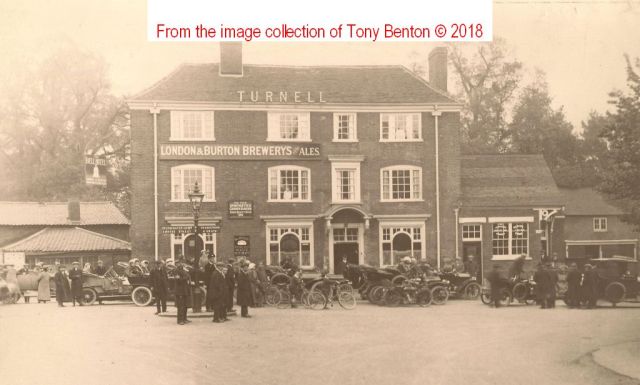
A large group gather outside the Bell c. 1920.
The owners GA Smith tried to diversify to extend the pub’s appeal, with an enlarged lounge bar extension plus a beer garden on the St Mary’s Lane frontage, and later a hall which was popular for weddings and dances. Luncheons and teas were also on offer but it seems that these efforts were to no avail in making the pub a going concern. In March 1960 The Story of Upminster (Book 10, P.25) reported “suggestions of removal and rebuilding” and looked forward to it continuing as “a building of character and worthy of its past”. But by the autumn of 1962 the Bell had closed and was awaiting its fate, which finally came with its sad demolition in the summer of 1963. Its replacement by an ugly modern corner parade of shops with a car park over, has long rankled with locals who fondly recall the Georgian hostelry in all its former glory.
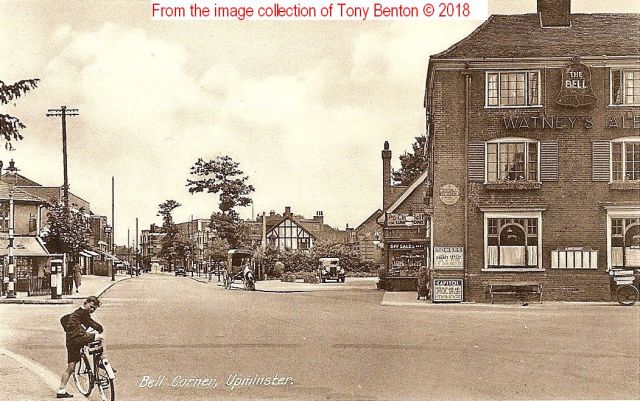
Bell Inn – late 1930s.

Very interesting reading such a pity The Bell was ever demolished I was born in Upminster and lived there from 1936 -1959 and remember it well
I remember this pub well. We used to pass it every week when we went to visit my aunt and my cousins who lived in Upminster in the 1950s. Such a shame when it was pulled down.
Reblogged this on Rani's Ramblings and commented:
I remember this pub well. We used to pass it every week when we went to visit my aunt and my cousins who lived in Upminster in the 1950s. Such a shame when it was pulled down
The pulling down of The Bell Hotel was an act of architectural vandalism and the replacement parade of shops with a car park on top a blight on the area and a disgrace to the architects who designed it and the authorities who allowed it.
I SO agree with all the above. How ever did that concrete monstrosity get past planning. The old pub was such a lovely building.
I was a pupil at the junior school next door when The Bell was demolished and remember seeing it being torn down and feeling sad for the building! I agree that it is baffling how the replacement was permitted.
Hi Caroline. It was the 1960s: considered to be progress to get rid of old buildings! I’ve had varying dates from Dec 1962 to summer 1963. Can you recall when it was?
Pingback: Who was Sir James Esdaile? | Old Upminster
I was at the infant school when The Bell was demolished, Must have been 1963.
Replaced with a grotty hardware store, and car park above.
My father knew the architect of the new building. Not a monstrosity I’d own up to designing.
Thanks Phil. When were you at the infant school?
Hello
I started there in September 1963.
I too went to the Bell school and remember the illuminated bell sign on the pub front. I must have started there 1962/3. Does anyone remember the music teacher. I think her name was. something like, Miss Kylick. She always wore a dark blue spotted dress for concerts.
Yes dorothy kyerlick taught at the Bell from 1927 to1968. She was born in Upminster in 1908and lived with her sister Jane . My my mother left Upminster in 1991 she was still alive and she was the music teacher.
I started at the Bell infant’s school in 1958 and recall the pub being demolished. It was 1963 and I have a photo somewhere that my (older) brother took at the start of the demolition. I well recall the deliveries of the beer as the barrels were rolled down through the hatch in the pavement to the cellar below. I lived in and around Upminster from 1958 until 2002 bar a couple of years away.
Funnily, I arrived at this site because I found myself singing one of the many songs that Miss Kyerlick taught us and was googling her name and that of the school.
Thanks for sharing: would be interested to see the photo if you locate it! Was the demolition Summer1963?
I’m afraid it will take a while to locate the photo, but when I do it will possibly give clue as to the season as I seem to recall that there were a number of trees in the grounds of the ‘Bell’ pub. I do remember that there was a very (to our eyes now) old fashioned pram in the foreground of the photo.
Hi – FYI, the picture supposedly of the interior of The Bell after a flood, is listed in the London Picture Archives as The Crown, Orchard Place, Poplar? It would be interesting to know where the confusion arose? If you look closely at the poster on the wall, you can just make out the word Poplar, so my money is on the LPA having the correct pub. Incidentally, the Turnells were ancestors of mine on my mother’s side.
https://www.londonpicturearchive.org.uk/view-item?key=T3siUCI6eyJ0eXBlIjoxLCJpZHMiOlszNDI0XX0sIlIiOiJHYWxsZXJ5In0&pg=74&WINID=1654421009056#CP5K4ljV5uMAAAGAmxEx8g/337172
Hi David. The photo was bought on ebay, some years back, along with an exterior of The Bell. As it clearly has been mis-sold, I’ll amend asap. Thanks for pointing this out.
You’re most welcome. I had been kind of hoping that the gentleman was one of my great or 2nd great uncles. They were a family of publicans.